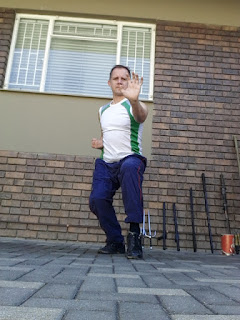Kungfu Moves in Karate- Move 4: Single Tiger emerges from Cave
Hello again, everyone.
Thank you for joining me. I am at the last chapter on moves found in forms of Karate and Kung Fu that are similar or even exactly the same.
This particular movement called "Single Tiger Emerges from Cave" consists of three elements that I will analyse separately.
Firstly- the stance being adopted may be known to even a lot of kyu-level students of styles like Shito and Goju Ryu as Cat Stance. In Chinese martial arts we find it being referred to as Tiger Stance.
While I have not yet seen any Karate katas showing it, one of the functions of this stance is to enable you to shoot into Bow (forward) Stance while attacking with a move like Black Tiger Steals Heart (which is a fancy Chinese name for Gyaku Zuki to put it simply).
The second element is the hand form called "Tiger Claw" that sweeps forward and outwards to deflect a straight attack. Hand forms are an integral part of Shaolin Kungfu and the Tiger Claw is but one of a number of these hand forms that include arcane looking hand forms like the Dragon Claw, One Finger Zen and the Sword Fingers.
These hand forms strongly resemble the mudras found in Hinduism and are evidence of Shaolin Kungfu being regarded by the Monks as not just a martial art, but also a Buddhist spiritual exercise.
The third element is the withdrawing hand. Shaolin Kungfu seems to share Karate's love for this concept more than Taijiquan or Wing Chun Quan/ Yong Quan.
In fact- although people generally credit White Crane Kungfu with the development of Karate this type of withdrawing fist (hikite) is not even found in the form that I have seen.
In Kungfu the Single Tiger is mainly used as a block against a straight, mid-level punch like the Black Tiger. In sparring, however, it is also a very popular "poise pattern" (or fighting stance/ kamae). Jeet Kune Do, Sanda and Karate athletes might scoff at this type of fighting stance, but the reality is that the one free leg can actually respond to an attack much faster with a kick or a side-step than a foot that has weight on it. When used in this manner the Tiger Claw serves as a guard ready to not only block a punch, but to grab hold of the attacking arm.
Now on to Karate...
Shukokai students will be able to tell you outright that this is Shuto Uke. :)
Goju and Shito Ryu students also perform Shuto Uke in this manner.
Karate, taking a more pragmatic approach to training than a spiritual one, does not bother with hand forms like the Tiger Claw. That is replaced with a neat Knife Hand with fingers, nicely together. On a personal note I can say that I'd prefer to keep my fingers together as well as an overextended pinkie can be a huge distraction in the midst of a fight.
Still- the Cat/ Tiger Stance is kept and the Shuto Uke performs exactly the same function as the Single Tiger.
Japanese styles like Shotokan and Wado have substituted the Cat Stance (Neko Dachi) for the Back Stance (Kokutsu Dachi). The sideways step creates the impression that the karateka now squeezes through a narrower space with his block. A conscious effort is made to keep the hikite over the solar plexus. It is said to be done for protection of this vulnerable spot. Not seeing it being done with techniques like Uchi Uke and punches tell me, however, that Japanese karateka are not really as concerned about the safety of their solar plexuses as we make them out to be, though.
Sensei Iain, however, has a very straightforward and practical use for the Japanese Shuto Uke, however.
This can't be done with the block from Cat Stance:
I have actually found 3 videos of Sensei Iain explaining the use of this block on Youtube.
https://youtu.be/Vw-wnObCc3U
https://youtu.be/NZoWIWLfcuc
https://youtu.be/h4MeTwPPKfQ
A lot of traditional Kung Fu teachers (Jeet Kune Do teachers are not among them) maintain that a student of their art does not attack first, but only responds to an attack against him/ her. From where I am looking at things a pre-emptive attack might sometimes be the best way to prevent a lot of unnecessary bloodshed. So- I work equally hard on ways of attacking first as I do on responses to attacks.
The Single Tiger comes in handy in this instance. In the previous post I have explained that the Swinging Punch's fluid arc path is a lot quicker than the pulling back and straightening out of a straight punch. Now- if I want to attack from a natural position with a powerful reverse punch (or Black Tiger punch) I need a way to set the opponent up. The Tiger Claw can serve here to get an arm out of the way or even to cover an opponent's eyes before I punch.
In Wudang forms that sweeping open hand can quickly transform into an uppercut.
I have now reached the end of my post. I hope you all have a great weekend and an awesome week ahead.
Next week's chapter shall be on the Horse Stance.













Comments
Post a Comment